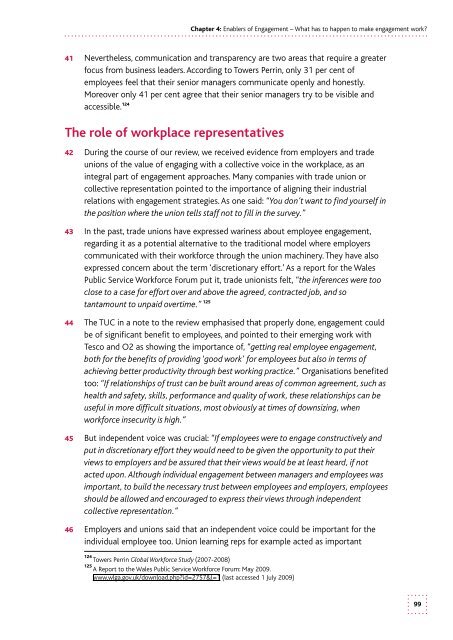3ytgeaf
3ytgeaf
3ytgeaf
You also want an ePaper? Increase the reach of your titles
YUMPU automatically turns print PDFs into web optimized ePapers that Google loves.
Chapter 4: Enablers of Engagement – What has to happen to make engagement work<br />
41 Nevertheless, communication and transparency are two areas that require a greater<br />
focus from business leaders. According to Towers Perrin, only 31 per cent of<br />
employees feel that their senior managers communicate openly and honestly.<br />
Moreover only 41 per cent agree that their senior managers try to be visible and<br />
accessible. 124<br />
The role of workplace representatives<br />
42 During the course of our review, we received evidence from employers and trade<br />
unions of the value of engaging with a collective voice in the workplace, as an<br />
integral part of engagement approaches. Many companies with trade union or<br />
collective representation pointed to the importance of aligning their industrial<br />
relations with engagement strategies. As one said: “You don’t want to find yourself in<br />
the position where the union tells staff not to fill in the survey.”<br />
43 In the past, trade unions have expressed wariness about employee engagement,<br />
regarding it as a potential alternative to the traditional model where employers<br />
communicated with their workforce through the union machinery. They have also<br />
expressed concern about the term ‘discretionary effort.’ As a report for the Wales<br />
Public Service Workforce Forum put it, trade unionists felt, “the inferences were too<br />
close to a case for effort over and above the agreed, contracted job, and so<br />
tantamount to unpaid overtime.” 125<br />
44 The TUC in a note to the review emphasised that properly done, engagement could<br />
be of significant benefit to employees, and pointed to their emerging work with<br />
Tesco and O2 as showing the importance of, “getting real employee engagement,<br />
both for the benefits of providing ‘good work’ for employees but also in terms of<br />
achieving better productivity through best working practice.” Organisations benefited<br />
too: “If relationships of trust can be built around areas of common agreement, such as<br />
health and safety, skills, performance and quality of work, these relationships can be<br />
useful in more difficult situations, most obviously at times of downsizing, when<br />
workforce insecurity is high.”<br />
45 But independent voice was crucial: “If employees were to engage constructively and<br />
put in discretionary effort they would need to be given the opportunity to put their<br />
views to employers and be assured that their views would be at least heard, if not<br />
acted upon. Although individual engagement between managers and employees was<br />
important, to build the necessary trust between employees and employers, employees<br />
should be allowed and encouraged to express their views through independent<br />
collective representation.”<br />
46 Employers and unions said that an independent voice could be important for the<br />
individual employee too. Union learning reps for example acted as important<br />
124<br />
Towers Perrin Global Workforce Study (2007-2008)<br />
125<br />
A Report to the Wales Public Service Workforce Forum: May 2009.<br />
www.wlga.gov.uk/download.phpid=2757&l=1 (last accessed 1 July 2009)<br />
99


